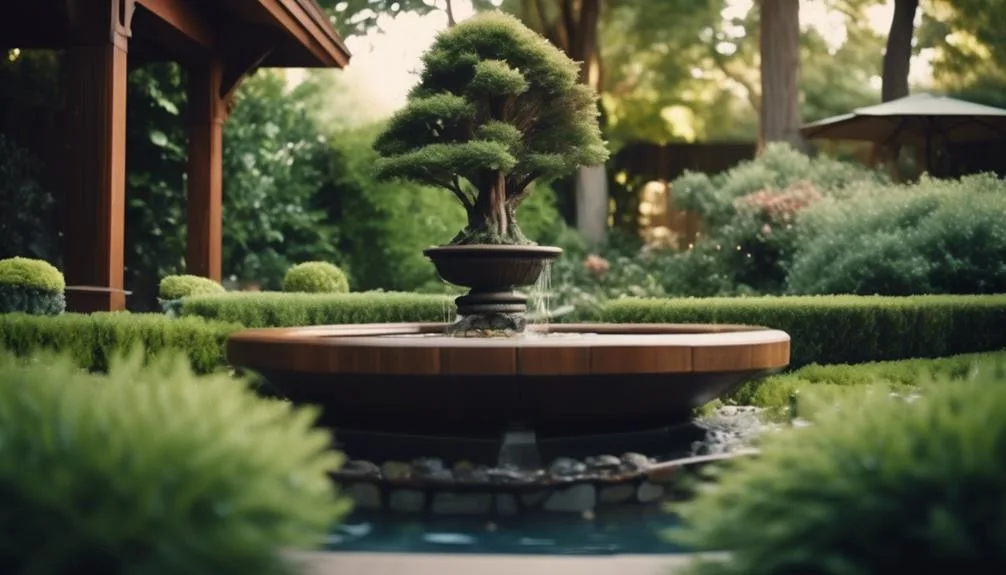You've moved into a new home with a big backyard and want to create a peaceful outdoor space.
Picture a tall redwood tree with reddish-brown bark and green leaves, giving shade and grandeur to your landscape.
Adding redwood trees can enhance the look and function of your outdoor area.
But how can you use these iconic trees in your design?
Let's explore incorporating redwood trees into your outdoor space for a more appealing and practical environment.
Benefits of Incorporating Redwood Trees
Incorporating redwood trees into your landscape design offers a multitude of benefits, ranging from their majestic beauty to their environmental advantages.
Redwoods make a stunning visual impact in any outdoor space, with their towering height and lush green foliage. Their grandeur creates a sense of awe and tranquility, enhancing the overall aesthetic appeal of your landscape.
Additionally, redwood trees provide significant environmental benefits, as they're excellent at sequestering carbon dioxide, contributing to cleaner air and a healthier planet. From an economic standpoint, the sustainability of redwood trees also offers long-term economic advantages, requiring minimal maintenance and providing shade that can reduce energy costs.
Choosing the Right Redwood Tree Variety
When selecting the right redwood tree variety for your landscape, consider the specific characteristics and growth habits that will complement your outdoor space. Here are some key points to keep in mind:
- Redwood Tree Identification: Choose between the coastal redwood (Sequoia sempervirens) for its tall, majestic presence or the giant sequoia (Sequoiadendron giganteum) known for its massive trunk and resilience.
- Redwood Tree Planting Techniques: Determine the available space and soil conditions to ensure the chosen variety can thrive. Coastal redwoods prefer moist, well-drained soil, while giant sequoias can tolerate a wider range of soil types.
Selecting the right redwood tree variety involves understanding their unique features and ensuring they align with your landscape's requirements for a harmonious and thriving outdoor environment.
Designing With Redwood Trees in Mind
Designing your landscape with redwood trees in mind allows you to create a striking and enduring natural environment that captures the beauty and grandeur of these magnificent trees. When considering redwood tree placement, envision how they can frame your outdoor space, provide shade, and enhance privacy.
Their towering presence can act as a focal point or create a natural boundary, adding depth and dimension to your landscape.
Additionally, integrating redwood trees into your design promotes sustainability and has a positive environmental impact. These trees are known for their ability to sequester carbon dioxide and contribute to cleaner air, making them a responsible choice for eco-conscious landscaping.
Maintenance and Care for Redwood Trees
To maintain the health and beauty of your redwood trees, it's essential to provide regular care and attention, including proper watering, pruning, and monitoring for pests or diseases.
Here are some tips to ensure your redwood trees thrive:
- Pruning Techniques: Use sharp, clean tools to remove dead or diseased branches, promoting healthy growth and maintaining an attractive shape. When pruning, avoid cutting too close to the trunk and be mindful of the tree's natural form.
- Soil Requirements: Redwood trees thrive in well-draining, acidic soil. Consider adding organic matter, such as compost or mulch, to improve soil quality and retain moisture.
- Monitoring for Pests and Diseases: Regularly inspect your redwood trees for signs of pests or diseases, such as discoloration, unusual spots, or pest activity. Address any issues promptly to prevent further damage.
Redwood Trees in Various Landscape Designs
Incorporating majestic redwood trees into your landscape can create a striking and timeless ambiance, adding natural beauty and grandeur to your outdoor space. When considering redwood tree placement, think about their potential height and width. These towering giants are best situated in spacious areas where their roots have room to spread, and they won't obstruct views or encroach on structures. Redwood tree height restrictions should also be taken into account, especially in urban or suburban settings. While some smaller redwood varieties exist, the iconic coastal redwoods can reach staggering heights, so be mindful of overhead obstructions. Below is a table to showcase the emotional impact of redwood trees in different landscape designs.
| Landscape Design | Emotion Evoked |
|---|---|
| Zen Garden | Serenity |
| Woodland Retreat | Tranquility |
| Modern Minimalist | Elegance |
Conclusion
Incorporating redwood trees into your landscape design not only adds natural beauty and shade but also creates a timeless outdoor space.
With the right variety and care, redwood trees can thrive and enhance the overall aesthetic of your garden or yard, whether you prefer a rustic, woodland feel or a modern, minimalist look.
Consider the lasting impact and sustainability of adding redwood trees to your landscape, as they can be a stunning and enduring choice for any outdoor environment.
Mark Hoffman is a dedicated arborist and tree care specialist with over a decade of experience. His love for trees began when he visited Yosemite National Park as a teenager and was awestruck by the giant sequoias. Mark pursued his passion by studying forestry at Michigan Technological University, where he earned a Bachelor of Science degree.
Since then, he has worked tirelessly in the field of arboriculture, helping to preserve and protect trees in his community. His expertise and dedication have made him a respected leader in the industry and a valuable resource for anyone seeking advice on tree care.
